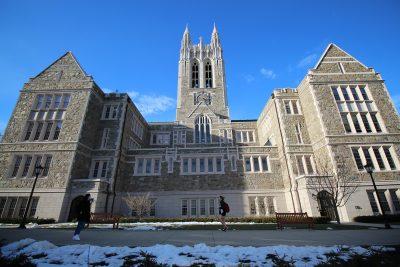Advocates at the New England Council are calling on Congress to double the maximum amount college students can be awarded for the federal Pell Grant.

In an open letter released Monday, the Council urged members of the New England House and Senate delegations to draft legislation that would increase the maximum award available to give to recipients displaying extreme financial need.
The Council, a coalition of businesses and organizations committed to advancing economic growth, argued that an increase in funding — currently more than $1.2 billion to students in New England, according to the letter — would make higher education more accessible for families with financial challenges.
“Doubling Pell would be the single most important step Congress could take to make college possible for low-income and first-generation college students,” Council President and CEO James Brett wrote in the letter. “Expanding the grant would also ensure that more working-class families are served through the program.”
The repercussions of an increase would be felt outside the education realm, said Emily Heisig, senior vice president of communications and federal affairs at the New England Council.
“The business community, they need to have a pipeline of college graduates who are prepared to take on some of the new jobs being created in our workforce,” Heisig said. “By making sure that more students have the ability to go to college, we’re making sure that there are eventually more workers to fill the needs of the workforce.”
From 1985 to 2018, the total price of tuition, fees, and room and board more than doubled among both public and private institutions, according to the National Center for Education Statistics.
“It’s kind of a fact in our country right now that college, for many individuals, is not affordable,” Heisig said, “and they need assistance.”
The current maximum award offered through the Pell Grant sits at $6,345, according to the U.S. Department of Education’s office of Federal Student Aid — through which the Pell Grants are awarded. Some advocacy groups claim now is the time for Congress to institute reforms controlling unaffordable costs.
Organizations that work with college students, low-income students especially, believe the “time is right,” said Brian Post, president of the New England Educational Opportunity Association.
If successful, a Pell Grant increase could have a significant impact for college-bound students with financial need.
“It hasn’t kept pace, by any means, with the cost of college,” Post said. “The argument on the right is they’ve kept pace with inflation. They have had increases for the past number of years, but just 150 bucks or something like that.”
While the cost of college has risen steadily, applications for financial aid dropped sharply during the past year, according to Anika Van Eaton, Massachusetts policy director at uAspire — a nonprofit that provides financial information to college applicants.
The Free Application for Federal Student Aid, which is tied to eligibility for a Pell Grant, saw an almost 7% decrease in applications among Massachusetts high school seniors, she said.
“This last year has been challenging for students and families on so many fronts,” Van Eaton said. “We see that this [lower FAFSA completion rate] is having a disproportionate impact on districts and schools with higher shares of low-income students and students of color who would benefit most from filing out the FAFSA.”
Even if legislators succeed in increasing the maximum amount awarded, the new grant would only cover a fraction of the total costs for students attending colleges and universities.
For example, during the 2017-18 academic year, around 2,800 Boston University students were awarded $13,189,760 in Pell Grant funds. That translates to an approximate average of $4,600 per student, or 9.18% of full-time tuition for that academic year.
Post suggested more systemic adjustment to ensure affordable education.
“I think colleges in general have to relook at things and reset,” Post said. “Because this is just a Band-Aid.”
Recent figures indicate the Pell Grant covers less than 30% of the average public bachelor’s degree, compared to 79% in the 1970s, making it “critically important” for Congress to prioritize a proposal to increase aid through this program, according to Van Eaton.
“It would support a lot of the students who we work with,” Van Eaton said, “who are low-income students, first-generation college students, who are disproportionately students of color.”
Although the New England Council’s letter emphasizes leadership by the federal government, Charlotte Peyser, senior policy and research analyst for the New England Board Of Higher Education, said additional action from individual states would be necessary.
“It’s going to take sustained commitment from the states for long-term funding for higher education,” Peyser said. “It is a bit of a partnership, but having the federal government issue, that double Pell is a foundational move encouraging states to make similar commitments.”
Neathery Brenzel, the parent of a Boston high school senior, said putting her son through college is a major financial challenge.
“We’re super positive and we totally want our kids to create these opportunities for themselves, but it is a concern,” Brenzel said. “You really do end up spending all your money that you would be saving for retirement on your kids’ school, and we have four kids, so that’s like four retirements.”
Brenzel added that stress over attending college is unfair given her son’s efforts to excel academically.
“This kid has worked his tail off,” she said. “For him to get to this point and be offered this and have his parents be stressed, it puts a pall on his acceptance to the school, that sucks. This kid should just be feeling awesome.”
















































































































